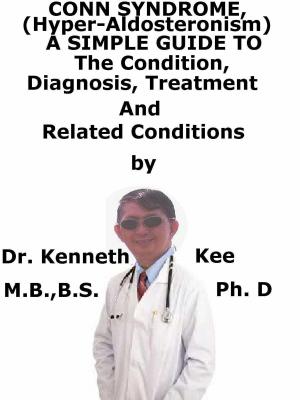Pancoast Syndrome, (Apical Lung Cancer) A Simple Guide To The Condition, Diagnosis, Treatment And Related Conditions
Nonfiction, Health & Well Being, Health, Ailments & Diseases, Respiratory, Cancer| Author: | Kenneth Kee | ISBN: | 9781370863860 |
| Publisher: | Kenneth Kee | Publication: | October 16, 2017 |
| Imprint: | Smashwords Edition | Language: | English |
| Author: | Kenneth Kee |
| ISBN: | 9781370863860 |
| Publisher: | Kenneth Kee |
| Publication: | October 16, 2017 |
| Imprint: | Smashwords Edition |
| Language: | English |
Pancoast Syndrome or tumors are cancers that form at the very top part of the lung (the apex).
Pancoast tumors are a subset of non-small cell lung cancers that invade the top of the chest.
Because of their location, they invade adjoining tissue
Cancers in the top part of the lung are rare.
Pancoast tumor normally spread into one or more structures in the top part of the chest which are:
1. The top ribs in the chest (the thoracic ribs)
2. Nerves in the top of the chest
3. Bundles of nerves close to the spinal cord
4. Blood vessels that supply blood to the arms
Most pancoast tumors are a type called non small cell cancer and most often squamous cell cancer.
Causes
The risk factors for almost all lung cancers are similar.
1. Smoking
2. Secondary smoke exposure
3. Prolonged asbestos exposure
4. Exposure to industrial elements (such as gold or nickel)
5. Exhaust fumes from cars
Symptoms
While a Pancoast tumor is a lung tumor, it rarely causes symptoms that are typically related to the lungs (like cough or chest pain).
ecause the cancer is at the top of the lungs, it might put pressure on or damage a group of nerves that runs from the upper chest into the neck and arms.
The group of nerves is called the brachial plexus.
Pressure on the brachial plexus can cause several very specific symptoms:
1. Severe pain in the shoulder or the shoulder blade (scapula)
The initial symptom is normally pain in the shoulder, the inner part of the shoulder blades, or both.
2. Pain in the arm and weakness of the hand on the affected side
The affected person normally needs to support the elbow of the affected arm in the opposite hand to ease the tension on the shoulder and upper arm.
3. Horner's syndrome
There is flushing on one side of the face and that side does not sweat.
The eye on the same side has a smaller (constricted) pupil with a drooping or weak eyelid.
4. In up to 25% of people with a Pancoast tumor, compression of the spinal cord and paralysis of the lower half of the body develop when the tumor extends into the opening between two vertebrae.
Diagnosis
Pancoast tumors can be difficult to diagnose.
There is a need for an MRI scan to help diagnose it.
Arteriogram or venogram with dye may show the lung cancer
Bronchoscopy may help
Biopsy can make a diagnosis in 95%
Mediastinoscopy and PET scan may show spread of cancer
Treatment
Treatment for a pancoast tumor is dependent on the stage of the cancer, its exact position in the lung and the general health
The standard of care for people with a Pancoast tumor is chemotherapy and radiation followed by removal of the tumor and a portion of the chest wall if it is affected or if its removal facilitates surgery.
The reason for the chemotherapy and radiation is to reduce the size of the tumor and to prevent the cancer from spreading through lymph nodes.
An interval of two to four weeks after the chemo and radiation allows the procedures to reach their maximal effect
After four weeks, all patients are reassessed for surgery.
If the cancer has not spread to distant areas of the body, surgery will likely be offered.
Surgery
Before surgery, the doctor carefully assesses and stages the cancer.
During surgery, the doctor normally removes a portion of the chest wall and part of the lung.
If the patient is fit enough to have surgery, he or she normally have a combination of chemotherapy and radiotherapy (chemoradiotherapy) first to shrink the cancer.
This is called tri-modality treatment.
The surgery requires removing the top two ribs or sometimes more.
Immunotherapy and targeted cell cancer therapy have changed the treatment of lung cancer and have improved survival rates tremendously.
TABLE OF CONTENT
Introduction
Chapter 1 Pancoast Syndrome
Chapter 2 Causes
Chapter 3 Symptoms
Chapter 4 Diagnosis
Chapter 5 Treatment
Chapter 6 Prognosis
Chapter 7 Horner Syndrome
Chapter 8 Immunotherapy for Lung Cancer
Epilogue
Pancoast Syndrome or tumors are cancers that form at the very top part of the lung (the apex).
Pancoast tumors are a subset of non-small cell lung cancers that invade the top of the chest.
Because of their location, they invade adjoining tissue
Cancers in the top part of the lung are rare.
Pancoast tumor normally spread into one or more structures in the top part of the chest which are:
1. The top ribs in the chest (the thoracic ribs)
2. Nerves in the top of the chest
3. Bundles of nerves close to the spinal cord
4. Blood vessels that supply blood to the arms
Most pancoast tumors are a type called non small cell cancer and most often squamous cell cancer.
Causes
The risk factors for almost all lung cancers are similar.
1. Smoking
2. Secondary smoke exposure
3. Prolonged asbestos exposure
4. Exposure to industrial elements (such as gold or nickel)
5. Exhaust fumes from cars
Symptoms
While a Pancoast tumor is a lung tumor, it rarely causes symptoms that are typically related to the lungs (like cough or chest pain).
ecause the cancer is at the top of the lungs, it might put pressure on or damage a group of nerves that runs from the upper chest into the neck and arms.
The group of nerves is called the brachial plexus.
Pressure on the brachial plexus can cause several very specific symptoms:
1. Severe pain in the shoulder or the shoulder blade (scapula)
The initial symptom is normally pain in the shoulder, the inner part of the shoulder blades, or both.
2. Pain in the arm and weakness of the hand on the affected side
The affected person normally needs to support the elbow of the affected arm in the opposite hand to ease the tension on the shoulder and upper arm.
3. Horner's syndrome
There is flushing on one side of the face and that side does not sweat.
The eye on the same side has a smaller (constricted) pupil with a drooping or weak eyelid.
4. In up to 25% of people with a Pancoast tumor, compression of the spinal cord and paralysis of the lower half of the body develop when the tumor extends into the opening between two vertebrae.
Diagnosis
Pancoast tumors can be difficult to diagnose.
There is a need for an MRI scan to help diagnose it.
Arteriogram or venogram with dye may show the lung cancer
Bronchoscopy may help
Biopsy can make a diagnosis in 95%
Mediastinoscopy and PET scan may show spread of cancer
Treatment
Treatment for a pancoast tumor is dependent on the stage of the cancer, its exact position in the lung and the general health
The standard of care for people with a Pancoast tumor is chemotherapy and radiation followed by removal of the tumor and a portion of the chest wall if it is affected or if its removal facilitates surgery.
The reason for the chemotherapy and radiation is to reduce the size of the tumor and to prevent the cancer from spreading through lymph nodes.
An interval of two to four weeks after the chemo and radiation allows the procedures to reach their maximal effect
After four weeks, all patients are reassessed for surgery.
If the cancer has not spread to distant areas of the body, surgery will likely be offered.
Surgery
Before surgery, the doctor carefully assesses and stages the cancer.
During surgery, the doctor normally removes a portion of the chest wall and part of the lung.
If the patient is fit enough to have surgery, he or she normally have a combination of chemotherapy and radiotherapy (chemoradiotherapy) first to shrink the cancer.
This is called tri-modality treatment.
The surgery requires removing the top two ribs or sometimes more.
Immunotherapy and targeted cell cancer therapy have changed the treatment of lung cancer and have improved survival rates tremendously.
TABLE OF CONTENT
Introduction
Chapter 1 Pancoast Syndrome
Chapter 2 Causes
Chapter 3 Symptoms
Chapter 4 Diagnosis
Chapter 5 Treatment
Chapter 6 Prognosis
Chapter 7 Horner Syndrome
Chapter 8 Immunotherapy for Lung Cancer
Epilogue















